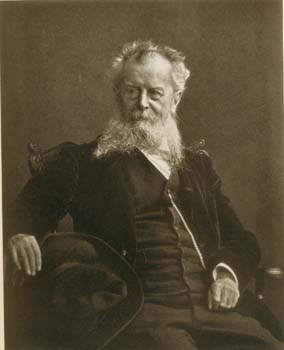Felix Dahn facts for kids
Quick facts for kids
Felix Dahn
|
|
|---|---|
 |
|
| Born | 9 February 1834 Hamburg, Germany
|
| Died | 3 January 1912 (aged 77) Breslau, Germany
|
| Spouse(s) |
Sophie Fries
(m. 1835–1898)Therese Dahn
(m. 1873–1912) |
| Parent(s) |
|
Felix Dahn (9 February 1834 – 3 January 1912) was a German law professor, German nationalist author, poet and historian.
Biography
Ludwig Julius Sophus Felix Dahn was born in Hamburg as the oldest son of Friedrich (1811–1889) and Constanze Dahn who were notable actors at the city's theatre. The family had both German and French roots. Dahn began his studies in law and philosophy in Munich (he had moved there with his parents in 1834), and graduated as Doctor of Laws in Berlin. After his habilitation treatise, Dahn became a lecturer of German Law in Munich in 1857. In 1863 he became senior lecturer/associate professor in Würzburg, received a professorship in Königsberg (in 1872).
Dahn was married to the artist Sophie Fries (1835–1898), with whom he had a son. He tutored baroness Therese von Droste-Hülshoff, a relative of the poet Annette von Droste-Hülshoff, in poetry from 1867 and entered an illicit love affair with her, which he gave a literary treatment in his Sind Götter? (1874). He divorced his wife and married Therese, against opposition from both families, in 1873.
Dahn relocated to University of Breslau in 1888, again as a full professor, and was elected rector of the university in 1895. As rector, he enforced a ban on Polish student associations. He was an honorary member of German Student Corps and an active member of the nationalist Alldeutscher Verband.
Dahn received honorary doctorates in Medicine and in Philosophy.
Dahn died in Breslau, a month before his 78th birthday.
Works
Dahn's writings were influential in the conception of the European Migration Period (Völkerwanderung ) in German historiography of the late 19th and early 20th centuries. His multi-volume Prehistory of the Germanic and Roman Peoples, a chronology of the Migration Period that first appeared in print in 1883, was so definitive that abbreviated versions were reprinted until the late 1970s.
From the 1860s, Dahn regularly wrote for Die Gartenlaube, Germany's most popular family magazine. His nationalist historical novels were widely received, and according to Houdsen (1997) were influential in the formation of the völkisch ideology that formed the "Germany's pre-Hitlerian intellectual background for National Socialism". His 1876 Ein Kampf um Rom according to Kipper (2002) contributed to the ethnic essentialism and opposition to ethnic miscegenation of the "völkisch avant-garde".
Dahn published numerous poems, many with a nationalist bent. His Mette von Marienburg portrays bands of "Masures and Poles" hiding in the "Podolian forest".
Besides his historical and literary production, Dahn also published a large amount of specialist legal literature, on topics such as trade law and international law.
See also
 In Spanish: Felix Dahn para niños
In Spanish: Felix Dahn para niños

